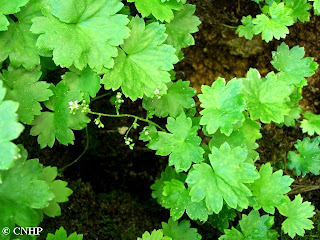As the first intern that CNHP has officially hosted from the department of Human Dimensions of Natural Resources at CSU, I would like to share the incredible experience that I have had this summer. The thrill of documenting the presence of a rare plant species, the satisfaction of crawling into a sleeping bag after a long but successful day in the field, and the pleasure of feeling like a valued and respected member of such a well-recognized organization, means my time spent at CNHP has truly been time well spent. From the amazingly beautiful canyonlands and shortgrass prairie of southeast Colorado to the diverse wetlands of Gilpin and Jackson Counties…from catching butterflies and toads with Zoologist John Sovell to analyzing the spread and control of invasive weed species with Ecologist Renée Rondeau and Director Dave Anderson, this field season has been extremely diverse, incredibly enriching, and downright exciting at times.
(barely visible in the photo, but it's there!)

I will always remember dangling Ecologist Joe Stevens off the side of a cliff by his ankles so he could collect a rare plant, jumping in the Purgatoire River after a long hot morning in the field, and swabbing a boreal toad between his toes to check for chytrid fungus. Most importantly however, I will never forget the knowledge that was passed on to me from CNHP concerning zoology, botany, ecology, and conservation biology; knowledge that I plan to apply in the future as a graduate student and biologist. So which project was my favorite to work on? The truthful answer is: …all of them! From taking soil samples in wetlands with Ecologist Dee Malone to identifying willow species with Botanist Janis Huggins; I have seen, experienced, and learned about the some of the best that Colorado has to offer!

Jessica and John Sovell reflecting on a long day’s work



















